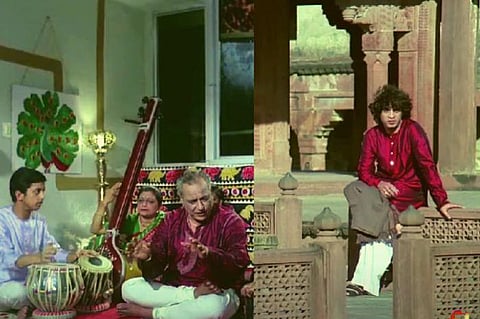
- HOMEGROWN WORLD
- #HGCREATORS
- #HGEXPLORE
- #HGVOICES
- #HGSHOP
- CAREERS
- ABOUT US
- CONTACT US

Classical music is one of the richest and most ancient gems birthed in India. Historians suggest that the origin of Indian classical music goes back to the Vedic times, around 2000 B.C. Although in the medieval era, music was used to popularize Hindu philosophies and religious ideas, around the 9th century, Sufi traditions had firmly taken root in India and by the 12th century, Islam started making a great impact on Indian Music. Amīr Khusrow, known as the ‘Father of Qawwali’, is credited with enriching Indian classical music by introducing Persian and Arabic elements to it. He was also the originator of the ‘Khayal’ and ‘Tarana’ styles that have become an integral part of Hindustani classical music.
In 1987, Usha Deshpande directed a documentary that covers the history of the ‘Khayal’ style and other Gharanas (schools) of Indian classical music called Khayal: A Musical Journey. It was produced by Films Division, a production company established in 1948 by Jawahar Lal Nehru under the Ministry of Information and Broadcasting in India. The documentary was also screened at The National Centre for the Performing Arts (NCPA) in Mumbai on July 13, 2012, with the aim of revisiting the art form’s history.
In this retro-style film, Zakir Hussain, the Indian tabla maestro traces the journey of Indian classical music from Vedic chants to song types called Prabandhs that evolved to Dhrupad and later Khayal Gayaki. The film brings forth the various dimensions of Khayal Gharanas including Gwalior, Kirana, Jaipur, Agra, Rampur-Sahaswan and Mewati. It also presents performances by the greats such as Bade Ghulam Ali Khan, Ustad Amir Khan, Alla Rakha Khan, Parveen Sultana and many more legends.
At one point, the sitar maestro Pt. Ravi Shankar sheds light on Ragas and their different permutations. He explains how delicate and obscure a system they are and how through various microtones (Shruti), a Guru breathes life into a Raga.
We also get to witness the santoor maestro, Pandit Shivkumar Sharma, take us through the spiritual experience of a classical music performance which aimed not to entertain, but to create an experience of ultimate bliss. “We expect the audience to be on the same wavelength, the same tuning”, he says. When the Raga, the instruments, the musician, and the attention of the listeners align, they reach a ‘destination’ and merge to become a single, transcendental entity.
Narrator, Zakir Hussain, talks about the Gharanas against the backdrops of the fort of Gwalior, the Taj Mahal, Amer Fort and other palaces in Jaipur; thereby blending the aesthetic intricacies of the architecture with the regional music traditions. The shots through the royal arches and windows of the palace instantly connect us to the heritage we come from. The performances by Ustads of each Gharana, set against the geometric stonework of forts and temples take us to an ancient realm of traditional Indian beauty.
This documentary is not just for the students and fans of classical music but is a must-watch for younger Indian generations. My father used to tell me about the lasting qualities of old Indian music and why it is considered evergreen, unlike the pop songs of my generation that “come and go”. Music based on or influenced by Gharanas and Ragas carries a code that is spiritual in origin, time-tested, and engineered to reach the deepest corners of your heart. It’s unexplainable and highly impactful. It’s exactly why current music producers fuse classical elements or techniques into their sounds that make us wonder why we like a track so much. It’s also the same reason why I have modern sub-genres like Slap House and Progressive Techno in my playlist but still can’t stop listening to Begum Akhtar. Khayal isn’t just a musical journey into the dynamics of classical music; it also triumphs in encapsulating centuries of history and the true essence of Indian culture.
